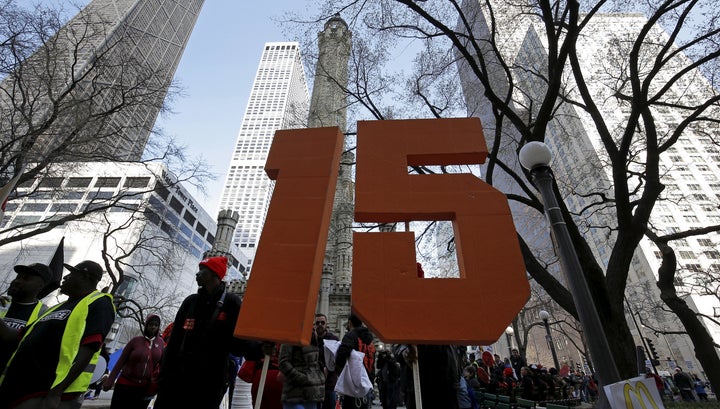
As legislators in Springfield debate a proposal to gradually raise Illinois’ minimum wage up to $15 an hour by 2022, opposing voices have argued that lifting the state’s wage floor would cost jobs. But a new analysis of major minimum wage increases in communities across America – including the state’s largest city of Chicago – provides further evidence that raising wages is a net benefit for working people.
Our research team recently completed the first study of the impact of Chicago’s minimum wage – now at $10.50 and eventually increasing to $13 by 2019 – and of the group of other U.S. cities, including Seattle, San Francisco and Oakland California, that currently have the highest minimum wages in the U.S. We compared job growth in Chicago and these cities with job growth in other economically comparable regions of the U.S., and found that higher minimum wages boosted worker pay without leading to any discernible loss of jobs or slowing of job growth to date.
Those findings are in line with the lion’s share of studies of past minimum wage increases in the U.S., which have found that any negative effects on employment have been very small. For example, our research team compared job growth in every pair of neighboring U.S. counties that have varying minimum wages – including every Illinois county bordering a neighboring state where the minimum wage is lower. That analysis similarly shows that the counties with higher minimum wages have not seen any discernible loss of jobs or slowed job growth.
Economic theory helps explain these results. It suggests that higher minimum wages can have both positive and negative effects on employment. Higher payroll costs will lead employers to automate some of their work and to raise prices slightly, which reduces sales and therefore employment. On the other hand, better paid workers stay on the job longer, reducing employers’ recruitment and training costs. Better-paid workers are also more productive for businesses. And because workers are also consumers, higher wages generate increased consumer spending and sales. These positive effects offset much of the negative ones, helping explain why the empirical evidence shows little net adverse effect on jobs from past U.S. increases. A good illustration of this phenomenon is the U.S. restaurant industry, which as minimum wages have gone up has seen increased automation and continued steady job growth go hand-in-hand.
There is not yet enough evidence to analyze the full impact of the $15 minimum wages that have been approved and are now phasing in in states like California, New York and the District of Columbia. However, our research team has developed a sophisticated model, based on past research, for estimating the combined positive and negative effectives noted above for a minimum wage at the $15 level. Those analyses in California and New York indicate that such larger minimum wage increases generate correspondingly larger boosts in consumer spending, that offset much of the higher costs to businesses.
Recent research has also shown that higher minimum wages are helping improve a broad range of other important societal outcomes for both workers and their children. These include reducing poverty, reducing reliance on taxpayer-funded safety net programs such as food stamps, improving infant health outcomes and improving adult mental health.
Claims of harmful impacts for workers and businesses when communities raise their minimum wages – and predictions of similar results under a state-wide $15 minimum wage – fly in the face of the available economic evidence. Instead, both the best research and economic theory suggest that the far-reaching benefits of a gradually phased in $15 minimum wage in Illinois would substantially outweigh the costs.
Michael Reich is Professor of Economics and Chair of the Center on Wage and Employment Dynamics at the Institute for Research on Labor and Employment (IRLE) of the University of California at Berkeley.
